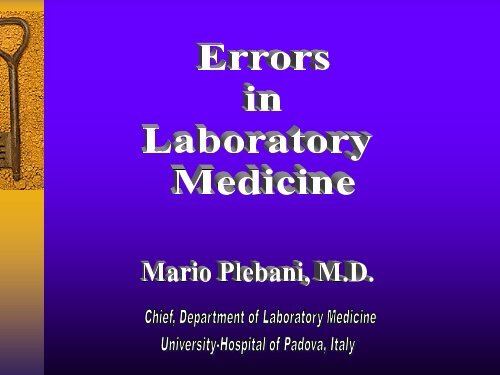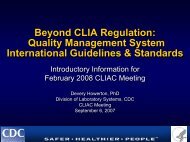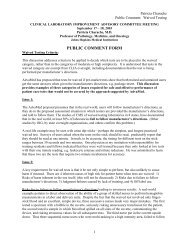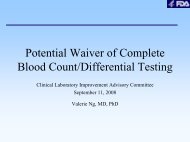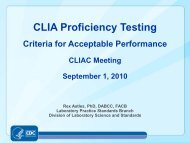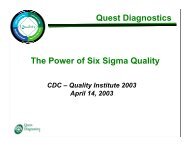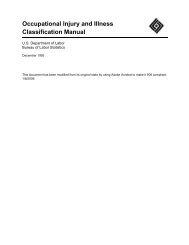Mario Plebani, MD
Mario Plebani, MD
Mario Plebani, MD
- No tags were found...
Create successful ePaper yourself
Turn your PDF publications into a flip-book with our unique Google optimized e-Paper software.
Kohn L.T., Corrigan J.M., Donaldson M.S., Eds. 1999
♦ Risk of death from avoidableinjury– 2,917 per 1,000,000
♦ The number of deaths that are reportedlyAmericans are killed in US hospital every6 months than died in the entire Vietnam♦ If true, the healthcare system is a publicdue to medical errors is disturbingly high.♦ The IOM report suggests that moreWar.health menace of epidemic proportions.
♦ There is a shortage of scientificevidence for documenting the types olaboratory errors and their frequencyand few studies consider the clinicaimpact of laboratory errors on medicaand economic outcomes.<strong>Plebani</strong> M, Bonini P. BMJ 2002; 324: 423-
♦ The literature on errors in laboratoryproblem, and for practical difficultiesin reporting and measuring the numbermedicine is scarce, both for theinsufficient attention paid to theof errors.Bonini P, <strong>Plebani</strong> M, Ceriotti F, Rubboli F
♦ Study design.♦ Errors in laboratory or errors inlaboratory medicine?♦ Difficulties in identifying all types oferrors.♦ Lack or changing of Gold standards.
♦ Most of the studies focus simply onanalytical errors, which represent only apercentage of the errors in the total testingprocess (TTP), which includes all pre-, intra-,and post-analytical phases.♦ Other studies are based on methodologies,such as the split-specimen design, that areinsensitive to some steps of the TTP.
Total errors patients involved:363• Pre-analytical Pre-- -steps 218 (45.5%)• Analytical steps 35 (7.3%)• Post-analytical steps 266 (47.2%)Ross JW, Boone DJ, 1991
♦ Apart from a reluctance in reportingtheir own errors, it is extremely difficultfor laboratories to identify all errorsbecause many errors will neitherproduce detectable abnormal resultsnor raise questions for the user.
♦ The reported errors are only the tip of theiceberg because, as stated by Goldschmidt,♦ a) 75% of errors produce results within thereference intervals.♦ b) 12.5% produce wrong results that are soabsurd that they are not considered clinically♦ C) the remaining 12.5% of errors may haveeffect on patient health.
♦ The new pathophysiologic insights andthe development of highly specific andsensitive laboratory tests have changedthe relationship between laboratoryinformation and the gold standards.
One identified error every33-50 events McSwiney and Woodrow (‘69)50-100 events Souverijn et al. (‘80)330 events Chambers et al. (‘86)1000 events Boone (‘90)2237 events Witte et al. (‘97)8300 laboratory results or2000 patients Lapworth and Teal (‘94)900 patients Nutting et al. (‘96)214 laboratory results <strong>Plebani</strong> and Carraro (‘97)164 laboratory reports Stahl et al. (‘98)283 laboratory results Hofgartner and Tait (‘99)
LapworthGoldschmidtNutting<strong>Plebani</strong> andStahl et al.and Teal (10) and Lent (7) et al. (36)Carraro (8) (37)ector of the laboratoryClinical chemistryWhole laboratoryPrimary careStat laboratoryWhole laboratorata collection period1 year6 years6 months3 months3 yearso. of test ~997 000 Nd aND 40 490 676 564 bo. of patients ~249 000 ND 160 714 NDNDo. of errors 120 133 180 189 4135 brequency0.05% of patients0.11% of 0.47% of test 0.61% b of testpatientsresultsPreanalytical phase 31.6% 53% 55.6% 68.2 75%Analytical phase 31.6% 23% 13.3% overall 13.3% 16% b(4.4% if if referrallaboratory; ; 40%if ifPOCT)Postanalytical phase 30.8% 24% 30% 18.5% 9% bMultiple phases 6%entification errors 41 (34%)77 (58%)ND 5 (2.6%)ND
♦ It is possible, even probable, that themost frequent pre-analytical errors arerepresented by an inappropriatechoice of laboratory tests or panel ofotests, and that most post-analyticaerrors derive from inappropriateinterpretation and utilization ofolaboratory results.
N° %• Total test requisitions examined 114,934• Total order entry errors 5,514 4.8• Test(s) ordered but not performed 1,658 1.4• Test(s) performed but not ordered 1,221 1.1• Physician name discrepancies 2,130 1.9• Test priority errors 934 0.8Arch Pathol Lab Med 1999;123:1145-50
No. Of missing resultsType of error Inpatients OutpatientsHemolyzed sample 8494 256Insufficient sample 3256 102Incorrect sample 1824 289Clotted sample 792 80Incorrect identification 287 2Lack of signature (blood group) 266 -Empty tube 238 8Lack or wrong compilation of theaccompanying module 120 -Sample not on ice 75 6Tube broken in the centrifuge 57 36Test not reserved 31 -Urine not acidified 24 -Open container 20 13Module without signature 14 -Urine volume not indicate 5 -
Total errors 64,000• Pre --analytical steps 52%• Analytical steps 5%• Post-analytical steps 43%Bachner P, Boone DJ, et al., 1991
ppm♦ Belk and Sunderman (1947) 162,116♦ College of American Pathologists (1996) 12,904♦ <strong>Plebani</strong> and Carraro (1997) 4,700♦ Witte D.L. et al. (1997) 447– (“pure”analytical errors)
NumberEffectononRiskofpatient carecareinappropriatecare(%) (%)J.W. Ross and336 30 7D.J.BooneP.A.Nutting et al. 180 27 12M. <strong>Plebani</strong>, P.Carraro 189 26 6.4
Facility typeTotal analyte Unsatisfactory Unsussessfuchallenges% (n°) % (n°)• Physicians'office656 21.5 (141) 4.4 (29)laboratories• Physicians'officelaboratories using 662 14.0 (93) 1.8 (12)medical technologistsNon-physicians'physicians'office2991 8.1 (243) 0.9 (26)laboratories• lHurst J., JAMA 1998;279:468-71.
(all other testing sites vs hospital and independent laboratories))AnalyteOdds ratio confidence(95% interval))•Allanalytes2.89•Potassium7.51 (6.59-8.54)•Theophylline5.5 (4.64-6.64)•Hemoglobin4.56 (4.08-5.09)•Uric acid 4. 32 (3.78-4.94)•Total bilirubin 4.28 (3.78-4.85)Stull TM et al., JAMA 1998;279:463-7.
In order to identify the most critical steps in theTTP and to set up a plan for a corrective strategywe have to make a distinction between:a) Errors exclusively inside the laboratory.b) Laboratory errors caused by organizationalproblems outside the laboratory.c) Errors at the laboratory-clinical interface.
Errors exclusively inside the laboratory:♦ Analytical errors♦ Acceptance of improper specimens♦ Sample mismatch during the analysis♦ Undue increase in TAT♦ Mistakes or failures in reporting
♦ Laboratory errors caused byorganizational problems outside thelaboratory should be defined“patient investigation errors”♦ (e.g. sample-patient mismatch duringthe blood withdrawal performed bynonlaboratory personnel).
Wrong Wristband1.1%Illegible Wristband7.7%Erroneous IDInformation6.8%Missing ID Information9.1%ConflictinWristban3.7%Missing Wristband71.6%Arch Pathol Lab Med 2002; vol. 126
♦ 1991 5.5 (10% of participants witherror rates ≥ 10.9%)♦ 1993 8.4 (hospitals with fewer than200 beds)♦ 1995 7.4♦ 1999 first quarter 7.4♦ 1999 eight quarter 3.05
Missing ID Differing ID Incomplete IDWrong Data Illegible Wrong Patient♦ Phlebotomy staff canmonitor♦ Interventions canreduce discrepancies♦ Reduced discrepanciesreduces disastersArch Pathol Lab Med1993;117:573-577
BONDJAMESdd/mm/yyMRAF007123456789012990088776655card antib aspirApplicazione protetta da brevetto
DRIVE - Drug in Virtual EnterpriseLaboratoryPRODUCTSWARDPRODUCTSPOINT-OF- OF-CAREDATADATADATAHospital ISPharmacy ISLaboratory IS
Errors at the laboratory-clinical interface:♦ Appropriateness in test request.♦ Appropriateness in test interpretation.♦ Appropriateness in test utilization.
♦ CBC/Diff reports have become increasinglylong and complex.♦ Unnecessary information provided toclinicians may impede their comprehension oessential results.♦ Simplification of reports might improvecomprehension of the results and therebyreduce the potential for medical errors.Linda M Sandhau, AACC 200
The CBC has become a monster!
Managing the risk of organizational accident - Reason, 1998 AshgaHAZARDS• Errors of individuals• Violations• Diagnostic mishap• Procedures/Processes• Cultural constraints• Legal and regulatory rules• Failures in communicationsInjuries and adverseincidents
(Procedures, Processes)Errors NOTassociated withnegative patientoutcomesErrorsassociated withnegative patientoutcomesInjuriesassociated witherrorsEvents included inerror-focused approachEvents included in adverseIncidents-focused approach
♦ There is a need for better definition olaboratory errors and their causes♦ In fact, we can agree that laboratory errorsmay be defined as “any defect fromordering tests to reporting results andappropriately interpreting and reactingon these”but
♦ It is important to classify laboratory errors byrelating them to their real or potential effectson patient outcomes, allowing definition of therelevance of the error itself.♦ (e.g. a hemolyzed sample is probably lessproblematic than sample mismatching or aTAT too long in a critical situation).
♦ A standard for laboratory error detectionand reporting needs to be defined, andan accurate analysis of the risk of errorsin the clinical laboratory needs to beperformed.
♦ It is important to define ways todecrease laboratory errorsand topossibly avoid completely those witha real or potentially significantnegative effect on a patient’s health.
♦ An appropriate error detection programand adequate measures forerrorreduction that quantify the effects ofthese measures and evaluate whetherthe reduction can be consideredsatisfactory are critical.
♦ Another fundamental step is to create aculture in which the existence of risk isacknowledged and injury prevention isrecognized as everyone’sresponsibility.
Scientific SocietiesLaboratory ProfessionalsCliniciansPatientsPublicERRORS REDUCTION MUST BEGIN AND ENDWITH RELATIONSHIPSMcNutt RA et al., JAMA 2002;287:1997-2001


